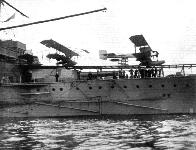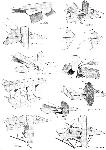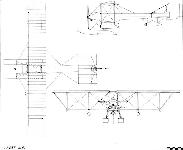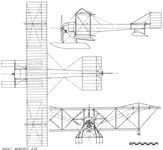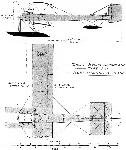
Описание
Страна: Великобритания
Год: 1912
Варианты
- Short - S.36 / S.45 tractor biplane - 1912 - Великобритания
- Short - S.41 seaplane - 1912 - Великобритания
- Short - S.68 - 1913 - Великобритания
- Short - Type 74 / Type 81 Folder - 1913 - Великобритания
- Short - Type 135 / Type 136 - 1914 - Великобритания
- C.Barnes Short Aircraft since 1900 (Putnam)
- M.Goodall, A.Tagg British Aircraft before the Great War (Schiffer)
- P.Lewis British Aircraft 1809-1914 (Putnam)
- J.Bruce British Aeroplanes 1914-1918 (Putnam)
- O.Thetford British Naval Aircraft since 1912 (Putnam)
- H.King Armament of British Aircraft (Putnam)
- Jane's All The World Aircraft 1913
- Журнал Flight
-
M.Goodall, A.Tagg - British Aircraft before the Great War /Schiffer/
Short S.41 land or seaplane was first flown in April 1912 (RNAS H.l and No.10).
-
P.Lewis - British Aircraft 1809-1914 /Putnam/
Early version of Short S.41.
-
C.Barnes - Short Aircraft since 1900 /Putnam/
Commander Samson in S.41 at Dover on 13 July, 1912, during his flight from Portsmouth to Harwich.
-
J.Bruce - British Aeroplanes 1914-1918 /Putnam/
The original Short S.41 seaplane.
-
Журнал - Flight за 1912 г.
The land station of the Naval Air Fleet at Portland during the manoeuvres of the Fleet last week.
-
Журнал - Flight за 1912 г.
The NAVY HYDRO-AEROPLANES. - A side view of the "Hibernia" showing the two hydro-aeroplanes on the launching platform especially constructed for this purpose.
Другие самолёты на фотографии: Short S.33 / S.38 seaplane - Великобритания - 1912
-
C.Barnes - Short Aircraft since 1900 /Putnam/
S.38 and S.41 stowed on the runway of H.M.S. Hibernia at Weymouth in May 1912.
Другие самолёты на фотографии: Short S.33 / S.38 seaplane - Великобритания - 1912
-
Журнал - Flight за 1912 г.
Commander Samson flying on his naval hydro-aeroplane over the King's yacht at Portland last week.
-
M.Goodall, A.Tagg - British Aircraft before the Great War /Schiffer/
Short S.41 improved versions S.56 and 57 (RNAS Nos.21 and 20).
-
C.Barnes - Short Aircraft since 1900 /Putnam/
RNAS 20 coming ashore at Great Yarmouth during trials of the G.R.W. beaching gear in July 1914.
-
J.Bruce - British Aeroplanes 1914-1918 /Putnam/
The Short S.41, serial number 20, flown at Great Yarmouth. The aircraft is here seen fitted with the G.R.W. Wheel Float Attachment.
-
C.Barnes - Short Aircraft since 1900 /Putnam/
S.41 as a landplane with experimental folding wings at Eastchurch in November 1913.
-
Форум - Breguet's Aircraft Challenge /WWW/
Short S.41 Tractor Biplane with 100 hp Gnome of RNAS 10
-
Журнал - Flight за 1913 г.
A study in tails.
Другие самолёты на фотографии: Avro Type E / 500 - Великобритания - 1912Caudron N - Франция - 1911Cody No.5 - Великобритания - 1912Farman HF.15/16/20 - Франция - 1912Grahame-White Type VI military - Великобритания - 1913Grahame-White Type VIII hydro - Великобритания - 1913Martin & Handasyde Model of 1912 year - Великобритания - 1912Maurice Farman MF.7 Longhorn - Франция - 1912Vickers No.6 / No.8 - Великобритания - 1912Wight No.1 Seaplane - Великобритания - 1913
-
C.Barnes - Short Aircraft since 1900 /Putnam/
Short Improved S.41
-
Jane's All The World Aircraft 1913 /Jane's/
"Short" Hydro Aeroplane Type S.41 100 h.p. tractor biplane.
C.Barnes Short Aircraft since 1900 (Putnam)
Short Tractor Biplanes (1910-12)
<...>
S.36 was intended only as an experiment, and was not offered for sale to the Admiralty, who were sufficiently impressed to order two more tractor biplanes, suitable for use from either land or water by exchange of landing gear. One was to have a 100 hp two-row Gnome engine and the other a 70 hp Gnome like S.36. The larger of these, S.41, was completed in March 1912, and there is some evidence to show that two separate fuselages were supplied for it, one with wheels and the other with twin floats. Its first flight, on wheels, was made by Samson on 2 April, 1912, with a more extended flight on 5 April, when he reached 60 mph without difficulty.
Apart from its more robust engine mounting, with front cross-bearer and round-topped cowl, S.41 was generally similar to S.36, except that the fuselage was slightly lower relative to the wings; this increased the ground clearance of the lower wing; as built, both the upper and lower centre-sections were open. S.41 was next converted into a seaplane, with two main floats pitched fairly close together and three streamlined air-bags, one under each wing-tip and one under the rear fuselage. The main floats were plain pontoons (steps were tried briefly but soon abandoned) and were placed well forward with a flat board between them to protect the airscrew. After satisfactory water take-off and alighting trials at Shellness, S.41 was flown to Sheerness, hoisted aboard H.M.S. Hibernia and taken to Weymouth for the Naval Review; on arrival on 3 May, Samson was lowered overboard in it and flew to a slipway at Portland, whence Longmore flew it on test next day; on 6 May Samson flew out 12 miles to meet the Fleet and escorted the flagship into Weymouth bay. There is no evidence that S.41 ever flew off the runway on Hibernia, which was used only by S.38, although the spare (wheeled) fuselage was available on board. On 10 May S.41 was hoisted aboard Hibernia and stowed on the runway ahead of S.38 and the ship sailed for Sheerness that night; early next morning, off Dover, Samson and S.41 were once more hoisted out and he took off, but had to come down off Westgate with engine trouble, being then taken in tow to Sheerness by the torpedo-boat Recruit.
<...>
On 3 June, 1912, having had an engine overhaul, S.41 was flown by Samson from Burntwick Island, Sheerness, to Harwich, to explore the Orwell and Stour estuaries and decide on the best site for a new seaplane station; after inspecting Shotley and Mistley, Samson recommended the Suffolk shore between Felixstowe Dock and Landguard Point, and this was how the Felixstowe Air Station, afterwards for so many years the home of the Marine Aircraft Experimental Establishment, originated. Samson flew back to Sheerness without incident on 14 June and then supervised the installation of a float chassis on S.45, which was in the works being repaired after a forced landing in fog.
<...>
Both S.41 and S.45 were flown to Portsmouth for the Naval Review in July. Samson, flying solo in S.41, covered the 194 miles round the coast from Eastchurch to Eastney in 195 minutes, most of the way at 2,000 ft. Spenser Grey and Sheppard on S.45 had to alight at Newhaven for engine adjustments, but were not much delayed. Both flew over the Fleet on 9 July, and on 13 July Samson flew S.41 back to Dover, moored in the harbour overnight and, with E. R. A. O’Connor as passenger, flew on to Harwich next day, a total distance of 250 miles. On the strength of these performances, the Admiralty ordered two more 100 hp Gnome tractor seaplanes, with minor improvements but substantially similar to S.41. The 70 hp seaplane was not so successful, and on 25 July reappeared on wheels, when Spenser Grey flew it to Dover, returning to Eastchurch next day. Although its single-row engine was reliable by current standards, its single float made it difficult to handle on the water.
On returning to Sheerness from Harwich on 27 August, after another of Samson’s coastal survey flights, S.41 was converted to a landplane for participation in the Army autumn manoeuvres in East Anglia. All three of the Naval Short tractors took part, Samson on S.41 setting out first on 5 September, but having to land near Bishop’s Stortford with engine trouble. Malone left Eastchurch in S.47 on 7 September and arrived before Samson at the rendezvous at Hardwicke, near Cambridge; finally, Gordon flew S.45 to Hardwicke on the 13th, and all three returned to Eastchurch on the 20th. The Triple-Tractor then went into the works for overhaul and the other two for modification and reconversion to seaplanes. S.41 emerged with little visible change except that its wings could now be folded back alongside the fuselage to economise deck or hangar space; the gaps in the upper and lower centreplanes were filled in and the rudder carried the new serial 10. S.45, however, was more drastically altered; the wings did not fold, but now had compensated ailerons acting up as well as down, and the extensions were braced by wires and kingposts instead of struts. The floats were unchanged, but the engine cowling was square-framed at the front, continuing the line of the fuselage longerons, with local bulges in the panels to afford clearance for the engine; a faired coaming was added to the top decking around the two cockpits, and the rudder carried the simplified serial 5. In this form S.45 became the prototype of three similar landplanes with dual controls (S.48-50), ordered by the War Office for use at the newly established Central Flying School at Upavon on Salisbury Plain. Both S.41 and S.45 were shipped to Carlingnose, near Rosyth on the Firth of Forth, which was opened as a temporary Naval Air Station on 2 October; it was not a good location for a seaplane base, and on 4 October, 5 capsized on landing after a flight by Lieut Gordon; it was towed ashore for repairs, but is not recorded as having flown again.
<...>
S.41 - Span 50 ft (15-3 m); length 36 ft 6 in (1115 m) as landplane, 39 ft (11-9 m) as seaplane; area 450 sq ft (418 m2); empty weight 1,100 lb (500 kg); loaded weight 1,600 lb (726 kg); speed 60 mph (96-6 km/h); duration 5 hr.
Short Tractor Seaplanes (1912-14)
When Winston Churchill became First Lord of the Admiralty in the autumn of 1911 the Royal Naval Air Service already existed in embryo, but lacked the means and authority to achieve legitimate birth. The Admiralty had opted three years earlier to spend all its available resources on a rigid airship, leaving no provision for aviation in the naval estimates. The Mayfly, built at Barrow-in-Furness, had come to grief before it ever left its dock, and only the munificence of Frank McClean (through the Royal Aero Club) and the voluntary services of George Cockburn had combined to make free flying instruction available to the first four Naval volunteer pilots. The value of aeroplanes to the Navy had been conclusively proved by April 1912, when the first all-service Royal Flying Corps, with Naval and Military Wings, came into being. Although both Wings combined to operate the Central Flying School at Upavon, the Naval Flying School at Eastchurch was allowed to continue in parallel, with a strong emphasis on experimental flying and fleet co-operation. By the end of 1912 the feasibility of seaplanes had been accepted, and, when the Weymouth Review ended, the Board of Admiralty authorised the purchase of no fewer than 25 new seaplanes, an unprecedented expansion at that date. Not all were to be of British origin, but the products of Short Brothers had shown their merit and were hardly challenged at home except by Sopwith, who was a newcomer to the industry. So Eastchurch works became steadily busier, and the demand was almost exclusively for twin-float seaplanes, strongly advocated by Horace Short.
The Short S.41, serial 10, had put up some notable performances in the hands of Charles Samson, and two more of the same type had been ordered, as already stated. These differed visibly from S.41 only in having an improved wing section, king-posts instead of strut bracing for the extensions, double-acting ailerons with return cables, and smaller lateral floats at the extreme wing-tips. They were ready for test by Easter 1913 and were ferried from Harty Ferry to Isle of Grain after being flown and passed by Gordon Bell on 23 April; on acceptance there, they received serials 20 and 21. Bell had become Short Brothers’ first staff test pilot, though only part-time, in December 1912, when Frank McClean found this duty too exacting to be continued on an honorary basis. Bell remained a freelance pilot, filling in with ferrying and demonstration flights for other firms, but gave Shorts first call on his services. On 13 June, 1913, he narrowly escaped death in a crash at Brooklands in a Martinsyde monoplane, in which his passenger, Capt J. R. B. Kennedy, was killed; later the Royal Aero Club censured him for reckless flying on this occasion, but he had learned his lesson and his certificate was not suspended.
<...>
Nos. 20 and 21 at Grain were used for experiments in wireless telegraphy, under the supervision of Lieut Raymond Fitzmaurice, who persuaded the Admiralty to buy four lightweight transmitters from Lucien Rouzet, engineer in charge at the Eiffel Tower, Paris. Flown by Babington, 20 could transmit messages up to 20 miles, and was the first aircraft to signal a salute to King George V, on his return from the Schelde in the royal yacht Victoria and Albert. In July, 20 was sent to Great Yarmouth, where it was to remain until scrapped in 1915. This station, on the unsheltered tidal beach of the South Denes, posed particularly difficult beaching problems, and 20 was used to pioneer the G.R.W. (Gregory-Riley-White) gear, comprising pairs of wheels which could be quickly attached to or removed from seaplane floats so that the aircraft could be taxied into or out of the sea under its own power. Both 20 and 21 suffered, like 10, from the unreliability of the two-row Gnomes, mainly due to the crude induction system from the carburettor via the hollow crankshaft and piston-crown inlet valves; this worked well enough in single-row engines, but was a haphazard arrangement for double-rows, where the rear cylinders always tended to receive too rich a mixture while the front ones were starved; inevitably the rear sparking plugs oiled up while the front ones overheated and misfired.
<...>
The production batch of 100 hp Gnome seaplanes for the Navy reached completion at the end of 1913. Somewhat lighter and of less wing area than 81, they had three-bay non-folding wings, being intended for coastal patrol from shore stations. The first of them, S.69, was test-flown by Gordon Bell on 4 and 7 January, 1914, C. R. Fairey being observer on the first occasion and Maurice Wright on the second, which included the delivery flight to Grain, where it received the serial 74. Bell tested S.70, the second of the batch, on 16 January, taking up both Fairey and Wright together on one flight. Four more (S.71-74) were tested during the last week of January, and the last (S.75) was flown straight to Grain without landing on 1 February. It is not clear from the records whether these seven aircraft were test flown from Leysdown or Sheerness, but the latter seems probable because there was a crane there for launching after rigging the floats and wings on the pierhead; the ‘folders’ could, of course, be taken from Eastchurch to the pier by road without dismantling. These seven non-folding seaplanes (74-80) were shared between the air stations at Grain (with detachments at Clacton and Westgate) and Dundee, and the latter provided a flight of four for the Spithead Royal Naval Review on 18-22 July, 1914. On the same occasion were flown four of the latest 160 hp ‘folders’ (S.82-85, serials 119-122'), which had gone into service at Grain in May and June. Their double-row engines still gave trouble and old No. 10 had been fitted with a similar 140 hp Gnome in May for Samson to experiment with; overheating had been reduced by fitting large vertical exhaust stacks in the tops of the cowlings, discharging over the upper wings clear of the crews; in true nautical style, these funnels were decorated with one, two, three and four white rings to identify the four ‘folders’ which took part in the Review. These four and a fifth (S.86, 186) differed from the first four in having longer fuselages and larger fins to match their three-bay wings of increased span, but 89 and 90 had three-bay wings of the same span as the two-bay 81 and 82 and retained the original fuselage length and fin area. Four more non-folding seaplanes similar to 74 were assembled at Eastchurch in July 1914, apparently from spares, and became 180-183; of these, 181 had an 80 hp Gnome and the others 100 hp Gnome-Monosoupapes.
On 15 June, 1914, the Calshot seaplane station, commanded by Longmore, had been inspected by the Board of Admiralty, including Prince Louis of Battenberg (First Sea Lord) and Winston Churchill (First Lord). The latter asked Longmore whether torpedo-dropping experiments already started by Flt Lieut Hyde-Thomson at Calshot could be speeded up; Longmore said they could if he were permitted to retain a certain 160 hp Short seaplane (which was 121), when he would undertake at an early date to carry and release a 14-in torpedo weighing 810 lb, which he had not so far been able to do with the Sopwith seaplane specially built for this task. This was agreed and (in Oswald Short’s own words):
‘Horace at once put in hand two new main float cross-bars, bent upward in the middle to allow the torpedo to be swung between the main floats clear of the water, and fitted a quick release catch [designed by Hyde-Thomson] to release the torpedo. With the late Gordon Bell, who was our test pilot, and Mr Bibby, one of our foremen, I went to Calshot Seaplane Base and erected the machine in a few hours. As I was talking to [Longmore] at his office door he received a telegram. He opened it and, having read it, remarked “We were nearer to war in 1911 than we are now”, but I did not know to what he was referring. ... By the time the machine was ready to take off it was already dusk. There was much activity too with the Sopwith torpedoplane which had been specially constructed for the purpose. It was at the water’s edge and mechanics were working on the engine. At Bell’s first attempt to take off, the Short seaplane did not gain enough speed even to straighten out the ailerons. I heard one of the rival mechanics say, “Safe as a house!” Gordon Bell returned to shore and reported one cylinder missing; this was soon put right and at the next attempt the seaplane took off, the torpedo was dropped and a magnesium flare attached to it enabled it to be found and picked up. It was now dark. This was the first torpedo taken up and launched from a seaplane in Great Britain, only a few days before war broke out.’
In fact, the date was 27 July, 1914, and from this account it is clear that, even though Longmore flew 121 with a torpedo next day, it is to Gordon Bell that the credit of having made the first drop should go. With such a load the aircraft was flown solo and could only carry fuel for about 30 minutes; even so, it was loaded well beyond the stress limits permissible even in 1914 for regular service, so it was far from being an operational weapon; in spite of this, the other four 160 hp ‘folders’ were later equipped with torpedo gear and carried on Engadine, one of three converted cross-Channel steamers, but no torpedo was ever launched by them in action. In March 1915, 120-122 were shipped to Durban on the armed liner Laconia and thence taken on 23 April to Niororo Island; there they were intended to assist the Navy in flushing the German light cruiser Konigsberg from deep cover in the Rufiji delta, but their performance in that hot, humid climate was totally inadequate.
The unreliability of the double-row Gnome led to alternatives being sought; in the case of the 100 hp seaplanes the remedy was found by replacing the original ten-cylinder two-row Gnomes by nine-cylinder single-row Gnome-Monosoupapes, and this may have been done at Grain before entry into service. An alternative to the 160 hp Gnome was more difficult to find, but the new range of water-cooled radial Canton-Unne engines produced in France by Salmson seemed promising. They were to be built under licence in England by the Dudbridge Ironworks of Stroud, Glos., and were already in use in the larger Farman, Sopwith and Wight seaplanes.
In September 1913 the Admiralty ordered two similar prototype Short seaplanes, one with the single-row Salmson of 135 hp and the other, slightly larger, with the double-row version rated at 200 hp. These were built at Eastchurch during March and April 1914 and resembled the 160 hp ‘folder’, but had stronger two-bay wings with strut-braced extensions and inversely tapered ailerons. Entirely by coincidence, the smaller seaplane was allotted the serial 135 and the larger 136; they were delivered to Grain in July and September 1914 respectively. On Christmas Eve they formed part of the complement of nine seaplanes, seven of them Shorts, aboard the three carriers Engadine, Empress and Riviera, which sailed with an escort from Harwich in an attempt to bomb the Zeppelin base at Cuxhaven. Early on Christmas Day all seven Shorts, which included also the 160 hp ‘folders’ 119 and 120 and three of a later class of 100 hp Mono-Gnome ‘folders’ {811, 814 and 815), got off the water with their bombs at a point 12 miles north of Heligoland; they failed to find the airship shed, but attacked other targets along the Kiel canal; three of them, including 136, returned to their flotilla after 3 hours, but 135 had engine failure and the pilot, Flt Lieut F. E. T. Hewlett (flying solo), was rescued by a Dutch fishing vessel, interned in Holland and later repatriated as a ‘shipwrecked mariner’. The other three seaplanes alighted near Norderney and their pilots were picked up by the submarine E11, but the aircraft had to be sunk to avoid capture. 136 was later allotted to the newly commissioned seaplane-carrier Ark Royal, which sailed from Harwich on 1 February, 1915, for the Dardanelles, arriving at Tenedos on 17 February. 136 was reported to be ‘the most valuable and only rough-weather seaplane on board the ship’, but was shot at by Turkish gunfire during a reconnaissance on 27 April, which damaged the floats and chassis and caused it to sink on alighting; it was hoisted aboard and patched up, but the engine never recovered from its immersion, and 136 had to be condemned on this account.
RNAS 20-21 - Span 50 ft (15-3 m); length 39 ft (11-9 m); area 450 sq ft (41-8 m2); empty weight 1,100 lb (500 kg); loaded weight 1,600 lb (726 kg); speed 60 mph (96-6 km/h); duration 5 hr.
Описание:






